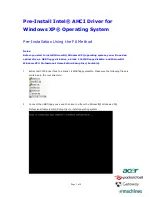
48
Copyright © Acronis, Inc., 2000-2010
Recovery
Parameters of software RAID arrays are not backed up, so they can only be recovered over a
basic volume, to unallocated space, or to a previously configured array. Recovery can be
performed in Linux or a Linux-based bootable media.
When started from bootable media, the bootable agent tries to access parameters of a software
disk array and configure it. However, if the necessary information is lost, the array cannot be
configured automatically. In this case, create a software array manually by using a command
such as
mdadm
, and then restart the recovery procedure.
For example, the following command creates an MD device /dev/md0 in the RAID-1
configuration on the basic volumes /dev/sdc1 and /dev/sdd1:
mdadm --create /dev/md0 --level=1 --raid-devices=2 /dev/sd[cd]1
For detailed information about recovering software RAID arrays in Linux and bootable media, see
Recovering MD devices (Linux) (p. 234) and Recovering MD devices and logical volumes (p. 264),
respectively.
Hardware RAID arrays
Hardware RAID arrays under Linux combine several physical drives to create a single partitionable
disk. The special file related to a hardware RAID array is usually located in /dev/ataraid. You can back
up hardware RAID arrays in the same way as ordinary hard disks.
Physical drives that are part of hardware RAID arrays may be listed alongside other disks as if they
had a bad partition table or no partition table at all. Backing up such disks does not make sense as it
won’t be possible to recover them.
2.11
Backing up virtual machines
Acronis Backup & Recovery 10 Advanced Server Virtual Edition allows for backing up virtual machines
from the host.
Preparation
On Windows 2008 Server x64 (any edition) or Microsoft Hyper-V Server 2008:
Install the Agent for Hyper-V on the Hyper-V host.
Integration services (p. 50) have to be installed on the guest systems.
On VMware ESX/ESXi:
Install the Agent for ESX/ESXi on the ESX or ESXi host. The agent is delivered as a virtual
appliance.
VMware Tools (p. 50) have to be installed on the guest systems.
Virtual machines backup
Once the agent is installed on the host and the required services are installed on the guests, you can:
back up a virtual machine or multiple virtual machines residing on the server without having to
install the agent on each virtual machine
recover a virtual machine to the same, another, or new virtual machine residing on the same
server or on another virtualization server where the agent for virtual machines is installed. The
virtual machine configuration, stored in a virtual machine backup, will be suggested by default at
recovering the backup content to a new virtual machine
back up and recover individual disks and volumes of a virtual machine.
















































